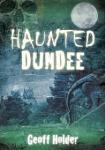
Reviewed by Tom Ruffles
Geoff Holder is one of the most interesting authors of paranormal guidebooks, combining as he does a deep knowledge of the subject and sensitivity to the historical context with an engaging writing style. He is unusual in that he is as much concerned to clear away myths and folklore (or “fakelore”) that accumulate round some factual kernel – or sometimes no substance at all – as he is to try to establish a paranormal aspect to a story. As a result, some long-lasting and no doubt cherished local legends are subjected to a critical analysis and found wanting. There is a great deal of historical background to the city included in passing, and as with the best gazetteers, you learn a lot about the place’s history while reading about its ghosts, whether they are convincing or not.
He has found a substantial number of accounts by combing newspaper archives, journals and websites, a quantity all the more surprising given that Holder himself points out that Dundee has been generally ignored by earlier writers. As well as presenting historical cases, he includes modern ones resulting from an appeal for people to tell him their experiences, some of which were rather unpleasant for the experients. It turns out that the city has a lively spooky history, and its exposure is long overdue.
Some of Dundee’s ghosts are standard-issue. For example, it has a wide selection of White Ladies, with a Black Lady for contrast, and some ‘hot spots’ linked to historical figures. More unusual are the ghost stories associated with the two famous ships which reside in Dundee,Discovery and Unicorn. The former is most closely associated with Captain Scott, but Holder rightly points out how difficult it is to determine an origin for paranormal reports, and how a link with a famous person can be spurious given the number of candidates for a ghost. Other highlights include a Spring Heeled Jack panic in 1883 and the paranormal heritage of the Tay Bridge disaster. The book concludes with a couple of descriptions of ‘fetches’, or doubles, taken from W T Stead’s Real Ghost Stories.
You would expect to see such material in this type of book, but Holder goes deeper and mulls on the problem of distinguishing what is ‘out there’ from what is ‘in here’, the extent to which people’s brains may be creating the experience, and he discusses various interpretations of ghosts, not all of which support the survival hypothesis. “Neuroscience is now the cutting edge of paranormal research” is not the sort of sentence one often reads in regional ghost guides, and it leads neatly in to a discussion of the work of Dundee psychiatrist James McHarg as set out in papers in the SPR‘s Journal.
McHarg identified two separate issues that bedevil any psychical researcher: apparent psi phenomena which turn out to be subjective and not paranormal, for example those claimed by schizophrenics or individuals experiencing hallucinations; and a smaller category, in McHarg’s estimation, of genuine psi phenomena arising from mental distress (but which might of course be misconstrued as subjective and not paranormal). This discussion should make the reader interested in the nature of ghosts want to look up McHarg’s papers in the SPR’s publications.
While open to the possibility that some experiences recounted are genuinely paranormal, Holder is keen to provide a normal explanation where the facts as known seem to warrant it, more so than some similar guides which uncritically present stories with no attempt to dig underneath to find out what might have happened. He is not a debunker, however, and if there is some aspect that defies explanation, he is happy to say so. That makes him a sceptic in the true sense of the term.
History Press’s production values are always good, and Holder has included a couple of maps, a list of places open to visitors, with access information, a very extensive bibliography, and an index, making this an excellent package. The book is well illustrated, mostly by the author’s own photographs, though sadly it turns out that one haunted corridor looks much like another. Haunted Dundee is a companion to Holder’s 2000 Paranormal Dundee, which had a broad Fortean remit, whereas the new book focuses more on ghosts. Each is fairly short, but together they provide a detailed ecology of weirdness that should satisfy the most demanding Dundonian.

